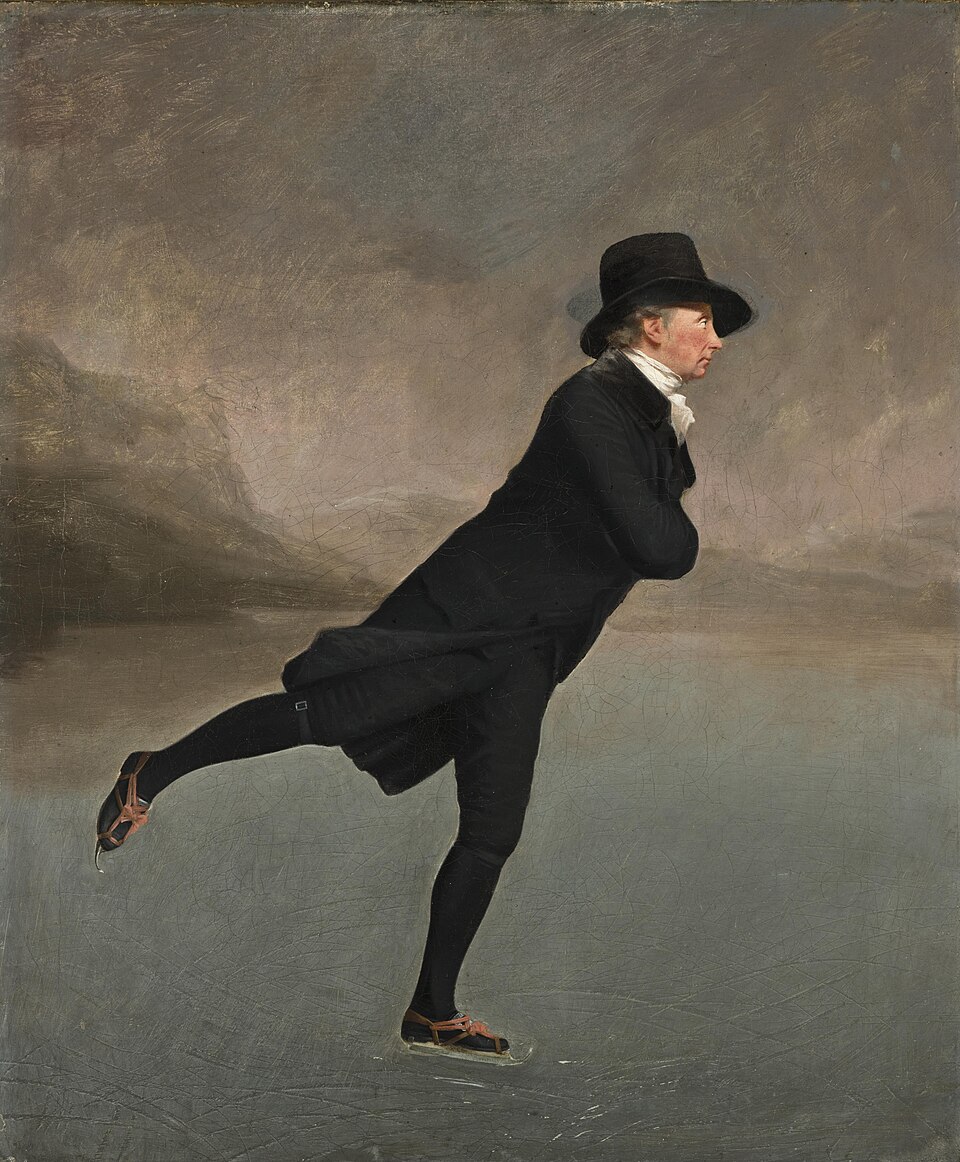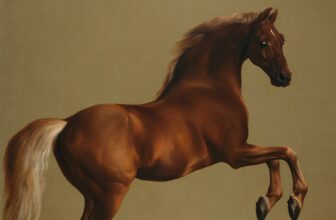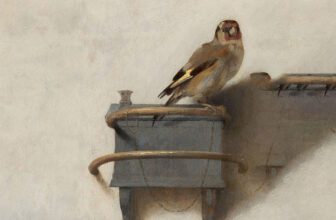
The Skating Minister Painting : Henry Raeburn’s Mysterious Masterpiece
In the serene chill of a frozen Scottish loch, a solitary figure glides gracefully across the ice, hands calmly clasped behind his back, clad in black clerical robes. This striking and enigmatic image is the heart of one of Scotland’s most iconic paintings: The Skating Minister. Formally titled The Reverend Robert Walker Skating on Duddingston Loch, this oil-on-canvas masterpiece has captured the imagination of art lovers, historians, and critics alike since it came to public prominence in the 20th century.
This article dives into the history, symbolism, and artistic significance of The Skating Minister, from its creation by Henry Raeburn to its meaning, context, and present-day location.
Who Painted The Skating Minister?
The painting is widely attributed to Sir Henry Raeburn (1756–1823), one of Scotland’s most celebrated portrait painters. Raeburn was renowned for his skill in capturing the character and stature of his sitters, primarily members of the Scottish Enlightenment elite. He was appointed Portrait Painter to His Majesty in Scotland in 1822 and enjoyed a prestigious reputation during and after his lifetime.
Though The Skating Minister differs in mood and setting from Raeburn’s typical works, most of which are formal, indoor portraits, it has long been accepted as part of his oeuvre due to stylistic consistency and historic provenance. However, some controversies and alternative attributions have emerged, which we’ll explore later.
What is The Skating Minister All About?
At first glance, the painting seems simple: a man skating on a frozen loch. But its beauty lies in this very simplicity, and the questions it invites. Who is the man? Why is he skating alone? What is the story behind this frozen moment in time?
The subject of the painting is Reverend Robert Walker (1755–1808), a Church of Scotland minister and member of the Edinburgh Skating Society, the world’s first figure skating club. Walker was born in Rotterdam but moved to Edinburgh as a child. Despite his austere profession, he was known to be an accomplished and enthusiastic skater.
The painting portrays him not merely as a clergyman but as a dynamic figure, confident, balanced, and at one with the icy environment. This depiction subtly defies the usual somber and stiff portrayals of ministers in 18th-century portraiture, suggesting that piety and grace, intellect and physicality, could coexist harmoniously.
What Type of Art is The Skating Minister?
The Skating Minister falls within the genre of portraiture, but it is also a landscape painting and even borders on being an action scene. This blend makes it particularly unique in Raeburn’s body of work and in Scottish painting more broadly. It straddles the line between Neoclassicism and Romanticism, two dominant artistic movements of the late 18th century.
Neoclassical traits: These include the calm dignity of the sitter, the clarity of form, and the subdued but harmonious palette.
Romantic elements: The moody atmosphere, the solitary figure amidst the vast natural expanse, and the evocation of emotion align more with Romantic ideals.
In terms of technique, Raeburn’s brushwork is confident and fluid. The icy surface of the loch is rendered with shimmering delicacy, and the cold winter sky adds a hushed, contemplative tone. The minister’s posture, controlled yet kinetic, shows Raeburn’s mastery of anatomy and movement, something not often seen in his otherwise stationary portraits.
Symbolism and Interpretation
1. Grace and Discipline
The painting is often seen as a metaphor for balance, both physical and moral. Reverend Walker, with his hands calmly behind his back and his eyes slightly downcast, embodies serenity and control. Skating itself requires both strength and finesse, suggesting that a moral life is not about rigidity, but about finding balance amidst motion.
2. Contrasts and Paradoxes
There’s an intrinsic contrast between the formality of Walker’s ministerial attire and the informal, almost playful activity of skating. This juxtaposition suggests that rationality and enjoyment, faith and leisure, are not mutually exclusive. It also humanizes the minister, presenting him as a man of intellect and discipline who also finds joy in the natural world.
3. Individuality in the Enlightenment Era
Walker’s solitary figure in a vast, open landscape may reflect Enlightenment ideals of individualism and introspection. At a time when Scotland was a hub of philosophical thought and scientific advancement, the image of a thoughtful clergyman skating alone could symbolize the harmony between intellect, spirituality, and nature.
4. Civic Identity
The painting also serves as a subtle homage to Edinburgh society. The city was not only a religious center but also a crucible of Enlightenment thinking. The Reverend, as both a spiritual leader and a cultured gentleman skater, becomes a symbolic figure representing Scotland’s dual identity, devout and enlightened, stoic and elegant.
What is Happening in the Painting?
On the surface, the painting captures a single moment: Reverend Walker skating across Duddingston Loch. But beneath this simplicity is a rich tableau of narrative possibility.
The light is soft, suggesting early morning or late afternoon. There are no other figures in the scene, lending an air of solitude and tranquility. The ice is glassy and still, reflecting the sky and the distant shoreline.
Walker’s posture is notable. Unlike modern ice skaters, who often use their arms for balance, he clasps his hands behind his back, a technique thought to offer better poise and rhythm. His gaze is downward, perhaps focused on the ice or lost in thought. This choice of pose adds a contemplative dimension, as if the act of skating is also a meditative or spiritual one.
Behind him, the barren winter trees and frosted landscape evoke a sense of stillness, reinforcing the painting’s introspective mood. This is not just a man enjoying a sport; it’s a man finding peace in nature and movement.
The Painting’s Mystery and Debates
Despite its apparent clarity, The Skating Minister has not been without controversy. For much of the 19th century, the painting was relatively obscure. It was brought into the public eye only in the 1940s, after being donated to the Scottish National Gallery.
Alternative Attribution
In the late 20th century, some scholars questioned whether Raeburn was indeed the artist. One theory posited that the painting might have been by the French artist Henri-Pierre Danloux, who lived in Edinburgh around the time of its supposed creation. The basis for this argument included certain French stylistic elements, particularly the treatment of the background and the dynamic pose.
However, these claims have never been universally accepted. While the debate briefly cast a shadow over the painting’s attribution, the majority of art historians continue to credit Raeburn, based on documented provenance and consistent stylistic analysis.
Where is The Skating Minister Painting Today?
Today, The Skating Minister resides in the Scottish National Gallery in Edinburgh, where it is one of the institution’s most treasured and popular works. It was officially acquired by the gallery in 1949 through the acceptance in lieu of tax scheme. Since then, it has become a symbol not just of Raeburn’s genius, but of Scottish cultural identity.
The painting is often used in promotional material for Scottish art and tourism and is beloved both nationally and internationally. Its unique blend of technical mastery, emotional resonance, and historical context makes it a perennial favorite among visitors.
Cultural Legacy and Popular Appeal
Beyond the museum walls, The Skating Minister has taken on a life of its own. It has appeared in books, advertisements, and even postage stamps. Its influence extends into modern visual culture and continues to inspire artists and writers.
One reason for its enduring popularity is its ambiguity. Unlike many portraits, which clearly signal status or achievement, The Skating Minister invites interpretation. Is this a portrait of personal serenity, a celebration of Enlightenment values, or a reflection on the transience of life? Each viewer may see something different, and that open-endedness has helped it remain relevant through the centuries.
A Masterpiece of Movement and Meaning
The Skating Minister is more than a portrait, it is a meditation on balance, solitude, intellect, and grace. Through a seemingly simple scene, Sir Henry Raeburn (or his possible French counterpart) offers a deeply layered image that reflects the values of the Scottish Enlightenment, the complexity of human identity, and the serenity of a fleeting winter moment.
It stands today not just as a technical triumph, but as an artistic enigma, both intimate and universal, composed yet dynamic. Whether you’re an art historian, a lover of Scottish culture, or simply someone struck by the serenity of a lone skater on a frozen loch, The Skating Minister offers a timeless, captivating vision that continues to glide elegantly through the annals of art history.




